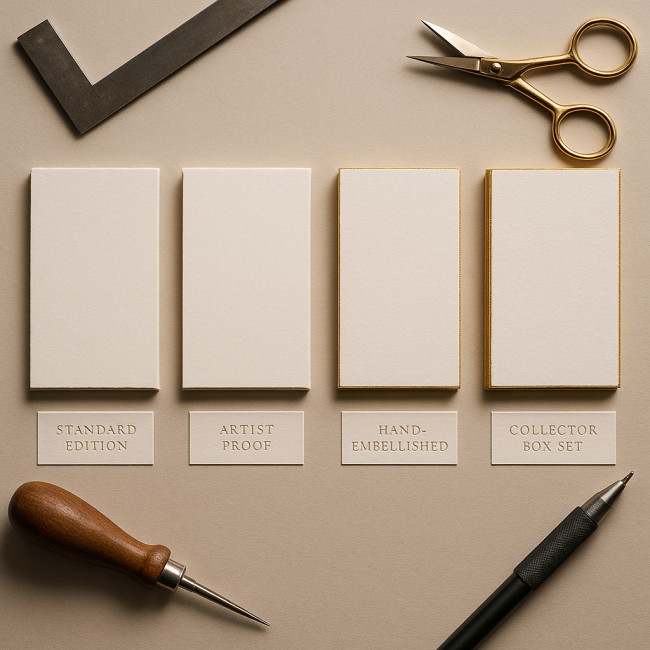Editioned print add-ons: use scarcity tiers to upsell hesitant collectors
Editioned print add-ons—artist proofs, hand-embellished variants, presentation boxes—trigger urgency and unlock higher margins. In this guide, you'll discover how to build credible scarcity tiers, price them, and present each option so even fence-sitting collectors feel compelled to upgrade.
Why scarcity-based add-ons persuade print buyers
Limited runs have long created buzz, but tiered add-ons compound that scarcity. Each extra—certificate upgrades, deluxe framing, unique surface treatments—reduces supply further and delivers a justifiable price lift.
- Cognitive bias: Collectors fear missing an enhanced version more than the base edition.
- Social proof: Premium tiers broadcast status when shared on social media or displayed in homes.
- Anchoring: Seeing a higher “deluxe” price makes the standard edition look affordable, while still nudging some buyers upward.
Map the scarcity tiers before you print

Pre-plan three or four clearly differentiated levels. Use the limited-edition royalty model framework to ensure your margins cover extra labour and fulfilment. Mapping tiers on paper before inks touch substrate forces you to calculate real scarcity, allocate certificate numbers consecutively, and predict how each upgrade—from gold leaf to bespoke frames—affects both production lead-times and post-launch marketing narratives. Documenting these variables now prevents budget overruns, colour batch discrepancies, and awkward mid-sale clarifications that can erode collector trust.
| Tier | Quantity cap | Typical add-ons | Average price uplift |
|---|---|---|---|
| Standard Edition | 100–250 | Signed, numbered | Baseline |
| Artist Proof (AP) | 10–15% of run | Embossed “AP” stamp, premium paper | +25–40% |
| Hand-Embellished | 15–30 | Spot gold leaf, varnish, remarque sketch | +70–120% |
| Collector Box Set | 5–10 | Archival box, process booklet, bespoke frame | +180–250% |
Key planning checkpoints
- Paper procurement: Make sure the rare stocks needed for top tiers are available in the same batch to avoid colour shifts.
- Legal clarity: Spell out quantities and exclusivity in your COA (Certificate of Authenticity) to avoid disputes later. If you also sell other collectibles, browse the glass run scarcity tactics article for cross-medium consistency tips.
- Archiving: Document every variation in a digital vault so future valuations stay transparent, mirroring best practice in mosaic print licensing.
Pricing strategy: tether premiums to tangible effort
Buyers accept mark-ups when improvements feel concrete. Use a cost-plus-value formula: (base cost + add-on labour) × perceived rarity factor. For hand-embellished tiers, tally studio time precisely—collectors appreciate transparency.
Benchmarking research from market reports shows deluxe boxed editions of contemporary prints sell for 1.9–2.3× the numbered run. Positioning your top tier within that range feels competitive yet aspirational.
Offer ladder vs. menu pricing
- Offer ladder: Present one choice at a time during checkout. Each “yes” unlocks the next upgrade, minimising overwhelm.
- Menu pricing: Display all tiers side by side. This works well at art fairs or on platforms like Artfolio's image-designer listings, where buyers compare editions quickly.
Copywriting formulas that convert
Scarcity alone is not enough; narrative sells. Follow the PAS (Problem–Agitate–Solution) framework in your product description:
- Problem: “Base editions can feel impersonal.”
- Agitate: “In a decade, will your print still stand out without a trace of the artist's hand?”
- Solution: “Secure a hand-embellished proof—each brushstroke certified unique.”
Embed editioned print add-ons repeatedly—aim for a 2–3% keyword density without sounding robotic.
Launch tactics: countdowns, VIP lists, and bundles
1. Micro-countdowns for each tier
Instead of a single launch timer, run individual countdowns as tiers sell out. This amplifies FOMO without spamming your audience.
2. VIP pre-sale access
Offer past buyers a 24-hour head start. They already trust your quality, and their early purchases create social proof.
3. Bundle with process content
High-tier buyers love behind-the-scenes collateral. A short making-of video or process zine echoes tips from mock-up presentation tactics, giving collectors a richer story.
Fulfilment tips: keep the premium experience seamless
Collectors paying top dollar expect flawless delivery.
- Packaging: Acid-free tissue, corner protectors, and a rigid mailer at minimum. For boxed sets, use a custom foam insert.
- Insurance: Declare actual value—under-declaring voids many policies.
- Documentation: Include a QR code linking to a provenance record so future resales maintain integrity.
Retention: nurture premium buyers post-sale
Send a personalised thank-you note 30 days after delivery and invite feedback. Offer them first refusal on upcoming releases—building a loyal base cuts future acquisition costs.
Quiz: Test your editioned print IQ
FAQ
- Do add-ons devalue the main edition?
- No. When quantities and upgrades are transparent, base editions keep their value while premium tiers satisfy buyers seeking extra rarity.
- Can I introduce a new tier after launch?
- Only if you stated that possibility upfront. Otherwise you risk breaking trust with early buyers.
- Is digital provenance enough?
- A blockchain COA is useful, but collectors still favour a signed hard-copy certificate—offer both.
- How do I handle international shipping for boxed sets?
- Use double-walled cartons, add corner braces, and select couriers that allow fine-art declarations. Declare true value for insurance.
Next steps
Editioned print add-ons turn a single artwork into a suite of irresistible offers. Sketch your scarcity ladder today, calculate fair premiums, and craft copy that speaks to collector psychology. Your revenue per print will climb—without increasing your total workload.
Ready to refine your edition strategy? Explore our deeper dive on edition sizes and rights to keep growth sustainable.











